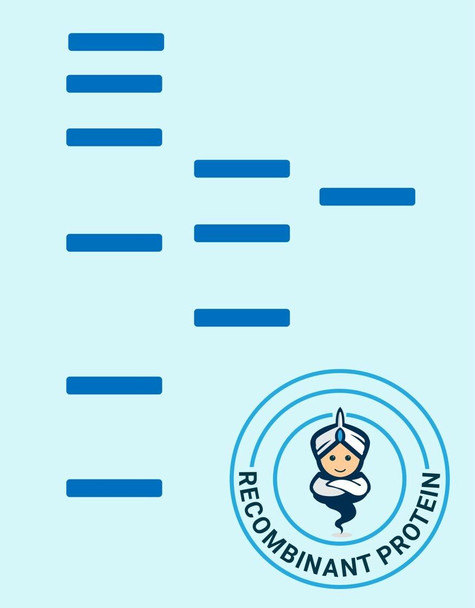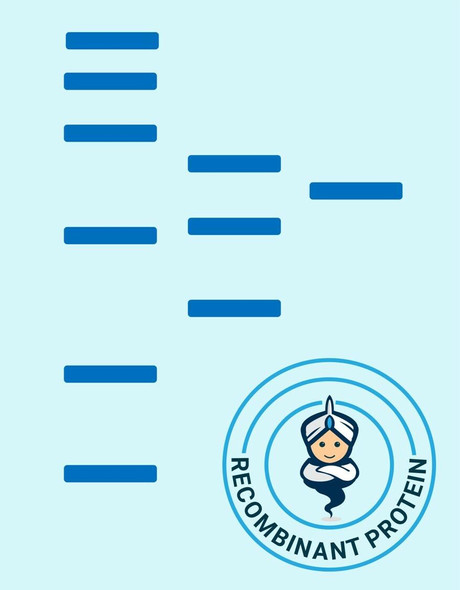Human IL 1 beta Recombinant Protein (RPPB0455)
- SKU:
- RPPB0455
- Product type:
- Recombinant Protein
- Size:
- 10ug
- Species:
- Human
- Target:
- IL 1 beta
- Synonyms:
- Catabolin
- Lymphocyte-activating factor (LAF)
- Endogenous Pyrogen (EP)
- Leukocyte Endogenous Mediator (LEM)
- Source:
- Escherichia Coli
- Uniprot:
- P01584
Description
| Product Name: | Human IL 1 beta Recombinant Protein |
| Product Code: | RPPB0455 |
| Size: | 10µg |
| Species: | Human |
| Target: | IL 1 beta |
| Synonyms: | Catabolin, Lymphocyte-activating factor (LAF), Endogenous Pyrogen (EP), Leukocyte Endogenous Mediator (LEM), Mononuclear Cell Factor (MCF), IL1F2, IL-1 beta. |
| Source: | Escherichia Coli |
| Physical Appearance: | Sterile Filtered White lyophilized (freeze-dried) powder. |
| Formulation: | The protein was lyophilized from a concentrated (1mg/ml) sterile solution containing 50mM Phosphate buffer pH=7.1 and 150mM NaCl. |
| Solubility: | It is recommended to reconstitute the lyophilized Interleukin-1b in sterile 18M?-cm H2O not less than 100µg/ml, which can then be further diluted to other aqueous solutions. |
| Stability: | Lyophilized Interleukin-1b although stable at room temperature for 3 weeks, should be stored desiccated below -18°C. Upon reconstitution IL1b should be stored at 4°C between 2-7 days and for future use below -18°C.For long term storage it is recommended to add a carrier protein (0.1% HSA or BSA).Please prevent freeze-thaw cycles. |
| Purity: | Greater than 98.0% as determined by:(a) Analysis by RP-HPLC.(b) Analysis by SDS-PAGE. |
| Amino Acid Sequence: | The sequence of the first five N-terminal amino acids was determined and was found to be Ala-Pro-Val-Arg-Ser |
| Biological Activity: | The specific activity as determined in the test of augmentation of lymphocyte proliferation assay using mouse thymus was found to be 200,000,000 IU/mg. |
Interleukin-1b is produced by activated macrophages, IL-1B stimulates thymocyte proliferation by inducing il-2 release, b-cell maturation and proliferation, and fibroblast growth factor activity. IL1B proteins are involved in the inflammatory response, being identified as endogenous pyrogens, and are reported to stimulate the release of prostaglandin from synovial cells.
Interleukin-1 beta Human Recombinant produced in E.Coli is a non-glycosylated, Polypeptide chain containing 153 amino acids and having a molecular mass of 17000 Dalton.The IL-1b is purified by proprietary chromatographic techniques.
| UniProt Protein Function: | IL1B: Produced by activated macrophages, IL-1 stimulates thymocyte proliferation by inducing IL-2 release, B-cell maturation and proliferation, and fibroblast growth factor activity. IL-1 proteins are involved in the inflammatory response, being identified as endogenous pyrogens, and are reported to stimulate the release of prostaglandin and collagenase from synovial cells. Monomer. Belongs to the IL-1 family. |
| UniProt Protein Details: | Protein type:Cytokine Chromosomal Location of Human Ortholog: 2q14 Cellular Component: extracellular space; extracellular region; cytosol; secretory granule Molecular Function:protein domain specific binding; interleukin-1 receptor binding; cytokine activity Biological Process: positive regulation of granulocyte macrophage colony-stimulating factor production; negative regulation of MAP kinase activity; positive regulation of nitric oxide biosynthetic process; activation of MAPK activity; positive regulation of transcription, DNA-dependent; positive regulation of interleukin-2 biosynthetic process; germ cell programmed cell death; negative regulation of insulin receptor signaling pathway; positive regulation of lipid catabolic process; positive regulation of NF-kappaB import into nucleus; fever; positive regulation of membrane protein ectodomain proteolysis; response to carbohydrate stimulus; activation of NF-kappaB transcription factor; cell-cell signaling; positive regulation of phagocytosis; positive regulation of T cell mediated immunity; positive regulation of T cell proliferation; neutrophil chemotaxis; positive regulation of I-kappaB kinase/NF-kappaB cascade; positive regulation of heterotypic cell-cell adhesion; positive regulation of mitosis; smooth muscle adaptation; interleukin-1 beta production; positive regulation of interleukin-6 production; positive regulation of angiogenesis; positive regulation of transcription from RNA polymerase II promoter; positive regulation of transcription factor activity; negative regulation of lipid metabolic process; sequestering of triacylglycerol; positive regulation of histone phosphorylation; apoptosis; positive regulation of interleukin-6 biosynthetic process; positive regulation of JNK cascade; signal transduction; positive regulation of vascular endothelial growth factor receptor signaling pathway; positive regulation of protein export from nucleus; positive regulation of interleukin-8 production; negative regulation of cell proliferation; negative regulation of lipid catabolic process; hyaluronan biosynthetic process; protein kinase B signaling cascade; lipopolysaccharide-mediated signaling pathway; inflammatory response; regulation of I-kappaB kinase/NF-kappaB cascade; cytokine and chemokine mediated signaling pathway; MAPKKK cascade; response to ATP; positive regulation of interferon-gamma production; positive regulation of chemokine biosynthetic process; positive regulation of prostaglandin secretion; positive regulation of fever; positive regulation of histone acetylation; immune response; positive regulation of protein amino acid phosphorylation; regulation of insulin secretion; embryo implantation Disease: Gastric Cancer, Hereditary Diffuse |
| NCBI Summary: | The protein encoded by this gene is a member of the interleukin 1 cytokine family. This cytokine is produced by activated macrophages as a proprotein, which is proteolytically processed to its active form by caspase 1 (CASP1/ICE). This cytokine is an important mediator of the inflammatory response, and is involved in a variety of cellular activities, including cell proliferation, differentiation, and apoptosis. The induction of cyclooxygenase-2 (PTGS2/COX2) by this cytokine in the central nervous system (CNS) is found to contribute to inflammatory pain hypersensitivity. This gene and eight other interleukin 1 family genes form a cytokine gene cluster on chromosome 2. [provided by RefSeq, Jul 2008] |
| UniProt Code: | P01584 |
| NCBI GenInfo Identifier: | 62906858 |
| NCBI Gene ID: | 3553 |
| NCBI Accession: | P01584.2 |
| UniProt Secondary Accession: | P01584,Q53X59, Q53XX2, Q7M4S7, Q7RU01, Q96HE5, Q9UCT6 |
| UniProt Related Accession: | P01584 |
| Molecular Weight: | 30,748 Da |
| NCBI Full Name: | Interleukin-1 beta |
| NCBI Synonym Full Names: | interleukin 1, beta |
| NCBI Official Symbol: | IL1B |
| NCBI Official Synonym Symbols: | IL-1; IL1F2; IL1-BETA |
| NCBI Protein Information: | interleukin-1 beta; IL-1 beta; catabolin; preinterleukin 1 beta; pro-interleukin-1-beta |
| UniProt Protein Name: | Interleukin-1 beta |
| UniProt Synonym Protein Names: | Catabolin |
| Protein Family: | Interleukin |
| UniProt Gene Name: | IL1B |
| UniProt Entry Name: | IL1B_HUMAN |










